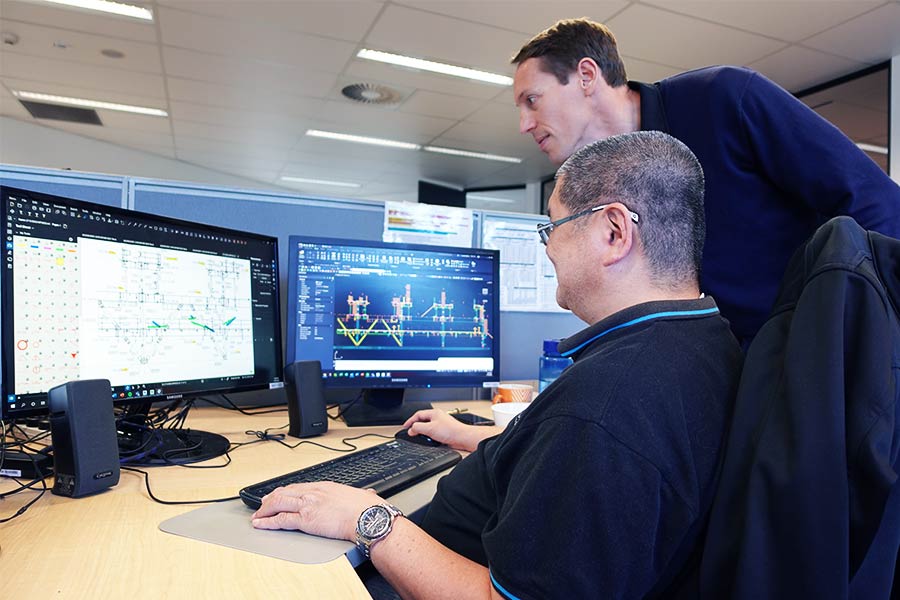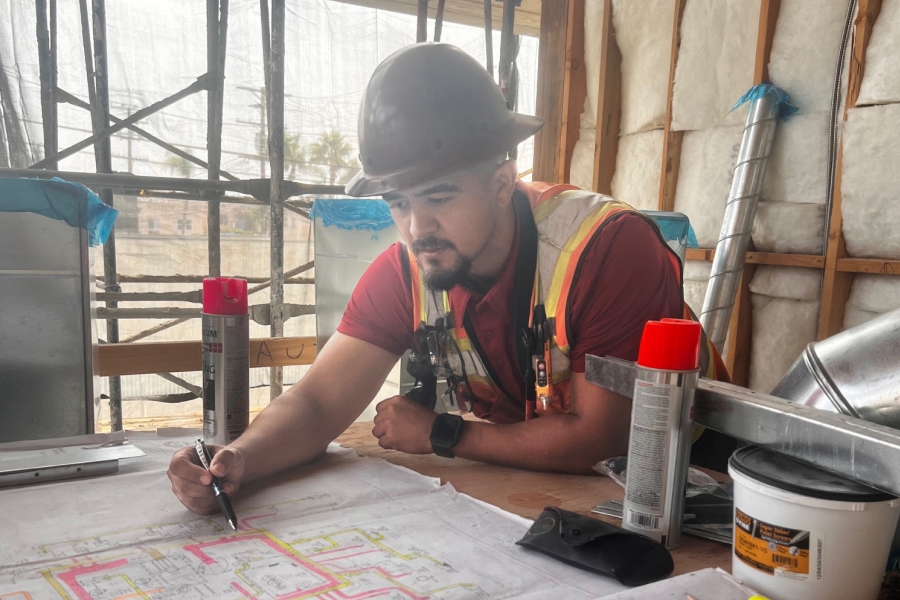Mechwest Design and Drafting is a mechanical and structural 2D and 3D drafting and shop detailing firm whose clients are primarily in the mining, oil and gas, industrial and commercial industries. Headquartered in a suburb of Perth on the western coast of Australia, the company has grown tremendously since its founding in 2001.
When Matt Mason, Mechwest’s operations manager, first started at the company around 2013, he was one of just six employees. Today, thanks to its exceptional track record of growth that has propelled the firm to open an additional Australian office on its eastern coast in Brisbane as well as an international outpost in the Philippines’ capital of Manila, Mechwest’s headcount has ballooned to more than 150 employees.
Mechwest is somewhat unique in the shop detailing industry, because it is one of the rare firms that offers a consultative approach, via Integrated Project Delivery (IPD) to its clients.
“Shop detailing refers to fabrication workshop detailing,” Mason said. “You might have some engineers and designers who will design and say … ‘The structure needs to be this big and I’ll engineer the size of the beams and columns.’ What we do is we, as the shop detailer, model everything in 3D exactly as it will exist on site—every single bolt, every hole, every tiny little bracket and item. And then, essentially, we create accurate fabrication data and reports to show fabricators how to fabricate every single item and then erect all of that on site.”

As a result, it’s not uncommon that Mechwest’s employees are working through as many as 20,000 documents per day. What’s more, employees’ work within a single document is breathtakingly fast compared to a typical document review-and-markup process. A colleague might be in one document for as short as a few seconds before moving along.
“It’s quite a high volume,” Mason said. “And that’s where we’ve struggled to find systems that could cater to that volume of drawings.”
Scaling up growth
Mechwest’s ability to manage such a massive volume of drawings became increasingly challenging as the firm continued to grow.
The company’s six employees in 2013 more than doubled to 15 by 2016, when Zane Isaacs, Mechwest’s production manager, joined the firm. The following four years to date have been marked by turbocharged growth. An ownership change, as well as strong organic growth, has allowed Mechwest to expand to its current more-than-150-employee headcount.
Mechwest’s growth was also fueled in large part by pivoting to an Integrated Project Delivery (IPD) method of working, which involves collaboratively improving efficiency and involvement of all participants through all phases of design, fabrication and construction.
Still, it wasn’t until around 2017-18 that the company’s growth, paired with its reliance on paper-based workflows, reached its breaking point.
“Even the shelves were starting to give way,” Isaacs said, “because the weight of the paper behind it. So, as we started to grow, we realized that we needed a better checking mechanism, because there was just tons of paper that was hard to efficiently keep track of.”
Prior to joining Mechwest, Isaacs ran his own structural steel detailing company, where he had been using Revu for about two years. Isaacs shared with Mason his experience working with Revu, which Mason was also familiar with. The two decided to give it a try.
“When we tested some different solutions, Bluebeam seemed to be the one that made the most sense,” Mason said, “because it was designed specifically for the engineering industry and it had a lot of the tools for marking up, which suited our business.”
Implementing Revu
Testing the software included Mechwest trying to first replicate its hard-copy process with a digital tool like Revu before developing the workloads and seeing how the software worked with adding files and synchronizing in different offices.
“Essentially, we aimed to find out: Could we copy and replicate our system into the digital space?” Mason said.
The answer: yes.
“We’d do one model and go in and refine it,” Mason said. “It’s quite user-friendly. We found with the interface, it was intuitive. It didn’t actually take our staff really that long to move over to the new system. A lot of our checkers are generally very experienced people that might not necessarily be highly technology focused. Some of them weren’t too sure how it was going to go, and they were a bit dubious of it. But, once they got using it, they had no problems with it.”
Once testing was complete, rolling out Revu company-wide was similarly quick.
Mechwest started by rolling Revu out to roughly 30 employees. Using some simple documentation and hands-on training with employees, Mechwest was able to get employees integrated in the new digital workflows with Revu quickly.
“Once we showed them how to use the tools, I guess Bluebeam is that intuitive,” Mason said. “Essentially, you’re just picking a tool like picking up a pen or a highlighter and writing or drawing something and then implementing it and moving on. We found it was very, very easy to adopt.”
Mason said Mechwest’s workflows mostly require using the markup tools and Tool Sets in Revu. “We’ve got welds and particular nodes that you can just drag and drop it into the drawing,” Mason said. “We synchronize those to everyone.”
Mechwest has also been using the Bluebeam compare tool to ensure the accuracy between different versions of documents. Mason said the company continues to explore how it can use other tools in Revu.
‘Even the shelves were starting to give way, because the weight of the paper behind it. So, as we started to grow, we realized that we needed a better checking mechanism, because there was just tons of paper that was hard to efficiently keep track of.’
Zane Isaacs, production manager, Mechwest
Amado Fulleros, a senior structural checker and one of the more experienced employees at Mechwest, said it took him about two weeks to become operationally proficient using Revu. “It was a little hard at first, but gradually it became easier to work with,” he said.
Stefan Giacomazzi, a document controller and junior draftsperson at the firm, who is in his first job in the industry and was never privy to Mechwest’s paper-based process, said stepping in and learning Revu was a non-issue.
“It was just the way that I knew we did things here,” he said.
Turbocharged legibility, accuracy
One of the most critical benefits to come from Mechwest’s adoption of Revu was the standardized legibility that naturally comes with digital transformation.
Accuracy is paramount in the shop detailing business. Not just accuracy in the standard sense—but accuracy of the most incredibly detailed variety.
“Our drawings have to be millimeter perfect,” Isaacs said. “And I guess that’s where Bluebeam allows us to have that, because we are having to open and close a drawing so quickly that we need to translate that information in a very quick but simple way.”
With its prior paper-based process, manual handwriting, highlighting and other markups had to be millimeter perfect as well—so much that Fulleros, along with the other checkers, would often use a magnifying glass to ensure that the small details in documents were precise.
“In Bluebeam, you can zoom in and see it perfectly,” Fulleros said.
Such millimeter-perfect precision isn’t optional at Mechwest. It’s the only option.
“We’ve only got one shot of getting these drawings right,” Isaacs said. “If we get them wrong, then the impact that it has on the construction side of things and the fabrication side of things is huge. Our cost is maybe 1% of the whole construction cost of that, so we are talking hundreds of thousands of dollars and man-hours as well if something goes wrong.”
Before Revu, catching errors after documents had been issued to a jobsite could be especially time-consuming, in the form of having to physically transport paper copies to jobsites, some of which are thousands of miles away from Mechwest’s offices.
“We would have to go to the jobsite, but even just compiling what paper copies we would have to send to the fabricator would take time,” Isaacs said. “It might take a whole day to get those paper copies to the fabricator, and the fabricator then has to sort through the package, push the relevant documents required into the workshop that needs to get fabricated, put them into the back of a truck and then have it transported up there. It was definitely a cost to be able to operate like that before.”
Furthermore, if there’s a need to audit the history of a document to find who marked up what, the Markups List in Revu becomes invaluable. “If there was some different detail or some different checkers working on a document, you can see who individually added each comment on there if there were errors,” Mason said. “It’s easier to trace back as well.”
Cleaning up the office, focusing the mind
Finally, the sightliest change to come for Mechwest thanks to Revu has been the physical appearance of its offices.
Out are large drafting desks with piles of paper; in are smaller, cleaner desks with multiple computer monitors.
By the end of the first month of using Revu, most of the paper in the office was relegated to the firm’s storage shelves, which quickly became overwhelmed. “We were able to actually utilize the space we had in a better way,” Isaacs said.
The decluttered offices aren’t just helping Mechwest’s employees have more space on their desks. The newfound cleanliness throughout its offices is helping employees’ productivity.
“The feel of the office feels like it’s more open. It feels more organized,” Isaacs said. “I think your presence of mind when you come into a space that feels that way is that you’re more focused as opposed to feeling like you’re drowning in all of this paperwork.”











